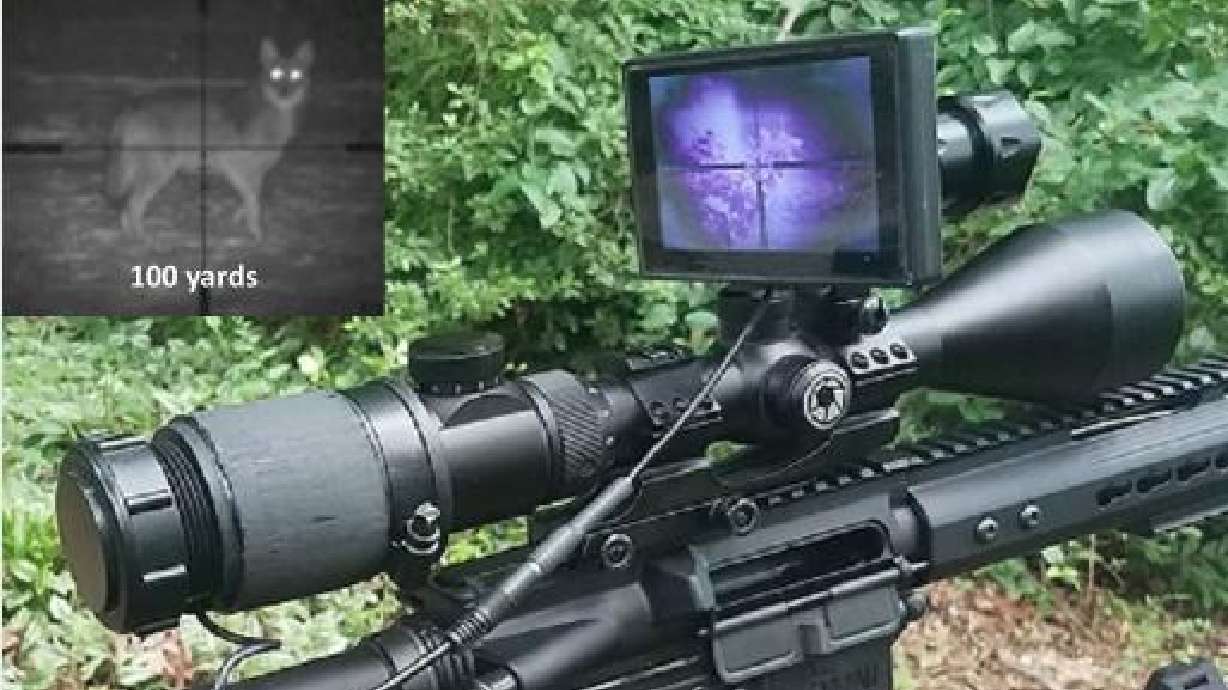Estimated read time: 4-5 minutes
This archived news story is available only for your personal, non-commercial use. Information in the story may be outdated or superseded by additional information. Reading or replaying the story in its archived form does not constitute a republication of the story.
RICHFIELD — Shaun Payne positioned himself behind his rifle, equipped with a camera clipped to the scope — the technology that displays the scope's view on a monitor. His spotter and friend, Stephen Miller, used a computer monitor to see Payne's targeting, adjusting the scope crosshairs onto the target.
Payne whispered his usual mantra before he pulled the trigger.
"I am a sandbag," he said. Then, he fired the rifle.
Since Payne has adopted the adaptive technology, he said he's been able to shoot several bullseyes — some from 1,000 yards away. The experienced marksman shows no shortage of talent, despite having been blinded by a motorcycle accident in Utah five years ago.
"It's just nice to be able to do something I enjoyed before (the accident)," Payne said.
Miller, a low-vision veteran whose partial blindness was caused by cancer, doesn't see complete blindness as a hindrance to Payne's performance; in fact, he views it as a boon to bolster his shooting scores. The two met at church and discovered they had a common interest in shooting.
"I think he has a talent for it because he's more attuned to what his body's doing," Miller said. "You know, he's not looking at the target or trying to hold the rifle on target; he's basically lying there, dead still."

The hardest part about the shooting, for Payne, isn't being 100% blind or adjusting the scope's target. Instead, it's breathing right and keeping still.
"When you're shooting that far, if you breathe wrong, it can throw you off up to a foot," Payne said.
The first time Payne shot with the adaptive equipment, he was nervous, shooting away from the target. He then discovered that by being completely still, or, as he said, acting like a sandbag, he can avoid sending the bullet off course.
Now, his techniques are earning him and Miller a spot at the Utah Long Range Championship and National Rifle Association Regional 1,000-yard shooting competition in Wendover on June 24 and 25, where he will compete against sighted shooters.
"That's pretty amazing that they're not in any special kind of class; they're competing with everybody else," said Charles "Chuck" Smith, a 100% blind marine veteran and user of the adaptive technology.
As a native Utahn, Payne and his family grew up hunting and fishing, so becoming blind proved those activities difficult. When he met Henry Johns, that all changed.
As the owner of Digital Crosshairs and a vendor with the Veterans Affairs, Johns has created adaptive rifle scopes for those with visual disabilities and other mobility limits.
Payne's Digital Crosshairs 1000SA has a camera that clips onto the eyepiece of the scope, a targeting display that shows the scope's view, and a battery pack attached to the stock of the gun. The spotter just needs to adjust the scope themselves — or help the shooter adjust the scope through verbal direction — and the shooter can fire away at the target.
"There's no other adaptive technology that I know of that enables assisted blind and low vision marksmen vying to compete with sighted sportsmen, in the challenge of hitting 10-inch plates at 1,000 yards," Johns said.
Johns also noted that Payne can compete in the Utah Long Range Championship because he will independently operate the rifle, while Miller directs him in adjusting the scope.
And it's not just Payne's life that John has touched, the technology helped Smith harvest a deer for the first time in 13 years.
After he received the magnifying scope as a gift, Smith said he was skeptical as to whether the technology would work. But during his first outing, he received verbal instructions on adjusting the scope and was able to hit his target.
The next day, Smith went hunting for a deer, even recording a video of his experience. All was silent as he changed the scope's direction with whispered instructions. And then, a shot rang out. A broad smile lit his face after he fired.
"When you lose your vision, people naturally tell you, 'You can't do that anymore' — and a lot of it's true, but a lot of it's not true anymore with technology," Smith said. "When you accomplish something like that, it makes you think, 'Well, what else have I been told that I can't do that I can try'?"









